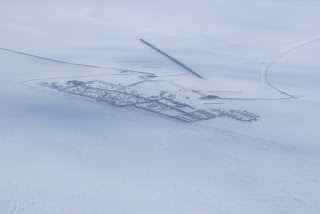Photo from Institute of the North - another legacy of Gov. Hickel
Last Monday was the funeral service for Governor Walter Hickel who was both a great Alaskan and a great friend of the Alaska SeaLife Center. I was, most unfortunately, not able to join Mrs Hickel, the Hickel family and so many good friends to recognize his extraordinary contributions to this State. Instead I was in Los Angeles at one of those meetings I had to be at – at the hour of his funeral I took a walk in the park to try and imagine what Alaska might have been like without him. That was appropriate as California was the State he came via on route from his native Kansas – true to form he had won a boxing championship there that enabled him to pay the boat fare.
There is a great story he used to tell about how he had originally chosen to go to Australia from CA, but couldn’t do that because he lacked a passport! I think he delighted in telling me that just so I could appreciate what Australia had missed out on! But Australia’s loss was truly Alaska’s gain and I can well understand why Alaska was his preferred alternative! Not only was it a long way from Kansas, it had the kind of rawness that he clearly needed to fulfil his destiny.
Unfortunately, the port of the City of Angels was not the sort of place I could easily relate to Wally and so the other night I took a walk again – this time around the waterfront in Seward. It was a beautiful evening – just right for contemplation.
As I walked, I tried to imagine how he must have felt when he arrived here in Seward with just a few cents in his pocket (see my May 2009 blog http://sealifeceo.blogspot.com/2009/05/learning-from-legend-drive-to-seward.html). I recalled his love of the landscape of Alaska – every corner on the Seward highway had a memory or a special connection for him – watching him gaze out over the ranges, you could quickly sense he was looking at and beyond the scenery… and that reminded me of his vision for what could be well before others could see the same idea.
I recalled especially the story he told me on the drive down about borrowing those few dollars to buy his train ticket to Anchorage… and I recalled the pride with which he shared how he paid the lender back in short order and then went on to become such a successful business man and politician – it was always going to be that way with Wally who so cherished the freedom to do things his way and quickly! That tale was well told in a recent KTUU feature (http://www.ktuu.com/global/story.asp?s=12497966).
His life was the quintessential manifestation of the American dream and yet, despite his extraordinary success, and exceptional oratory, Wally never lost touch with his roots. I remember going with he and Mrs Hickel to the Moose Pass Lodge for lunch on the way back from Seward last year. While there he struck up a casual conversation with the manager and they discovered they came from the same farm region of Kansas – of course that drew forth a series of great childhood memories and stories that must be some of the few that are not written down elsewhere as he seemed to delight in telling them with new insight.
I count getting to know Governor Hickel over the past year as one of the true privileges of my job – he was so supportive of the SeaLife Center that he would often call up to invite me over to the Captain Cook to give him an update. Invariably that would lead to a series of stories about the battles he had fought on our behalf to get the Center built and operational. We owe him a lot for the fight he put up on our behalf. And we owe him and the Hickel family a lot for their generous support for the Center over many years – even down to naming us one of the four preferred charities for memorial contributions.
Gov. Hickel acknowledging the Crowd at Fish for the Future
(photo courtesy of Seward City News)
I’d like to think that we repaid some of that debt to Wally last year when, at the Fish for the Future banquet in the Center, we gave him an early 90th birthday party. He loved the good-natured ribbing from Mr. Whitekeys and the song by Randy Altermatt! Throughout the night he’d turn to Ermalee or Karla or myself and make a joke or just tell a random story that reminded us, in a very humble way, of his magnanimous contributions to Alaska.
I’d also like to think that with the ongoing Alaska Marine Gala and Ocean Hero Awards we will continue to recall and recognize his contribution to our work – last year, the Hickel family generously supported the establishment of the Walter J. and Ermalee Hickel Award for Individual Contributions to Alaska Oceans – fittingly we recognized two leading Alaskans, and good friends of the Hickels, Senator Ted Stevens and Dr Vera Alexander.
We’ll miss you Governor, but we have already begun to plan a way to honor your contribution to the Alaska SeaLife Center – our Board is currently considering a permanent memorial at the Center and will consult with Ermalee and Malcolm soon on that.
As you look down on Seward, I hope you’ll take a moment from your review of how the heavenly commons works to see the good work we continue to do in honor of your vision… and just maybe Woody will give you a wink just like he did last time you sat in front of his tank!
















